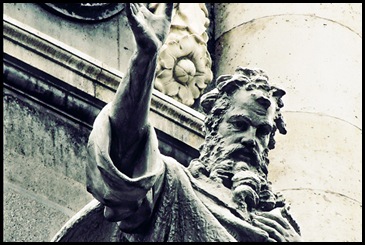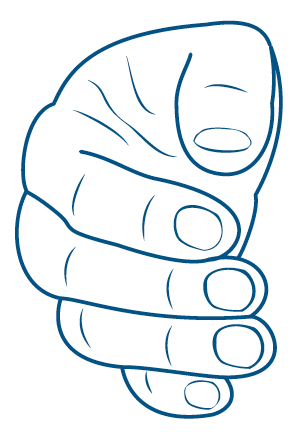
St. Irenaeus of Lyon (c.130-202 AD)
Explanation of the Logo
Some years ago, my wife, Debbie, and I were discussing Christian symbols. She pointed out that there were common symbols to represent Jesus (like the cross and a lamb), and to represent the Holy Spirit (a dove). But she couldn’t think of any symbol that has been used to represent the Father. Neither could I.
Around the same time, my daughter—who was studying at a Christian university in Canada—introduced me to one of the early church fathers, St. Irenaeus.
As I began reading some of his writings, beginning with an English translation of his shorter work, The Proof of the Apostolic Preaching, I discovered that he often referred to the Father. Later, I ran across a citation from his more famous work, Against Heresies, that gave me the idea for the logo of this website. St. Irenaeus spoke of God’s Word and God’s Wisdom, the Son and the Spirit, as the two ‘hands’ of the Father—by whom human beings were formed in God’s image, and through whom also our salvation has been accomplished and we have been led back to the Father. Here are the more extended quotes from St. Irenaeus’ work, Against Heresies.
God’s Word and the Spirit, are acting continuously in the history for the salvation of humanity to lead us to the Father. (AH IV.1) It was not angels, therefore, who made us, nor who formed us… nor any Power remotely distant from the Father of all things. For God did not stand in need of these, in order to accomplish what He had Himself determined with Himself beforehand should be done, as if He did not possess His own hands. For with Him were always present the Word and Wisdom, the Son and the Spirit, by whom and in whom, freely and spontaneously, He made all things, to whom also He speaks, saying, "Let Us make man after Our image and likeness;" (AH IV.20.1)

Thus, was God revealed: God the Father is shown forth through… the Spirit indeed working and the Son ministering, while the Father was approving and man's salvation was being accomplished. (AH IV.20.6)
While we cannot yet see the Father, we have nevertheless experienced the touch of his two hands. Thus in my logo, I have represented his right hand as the hand that reached out: first as God's Word at creation to shape us in our Father's image and likeness, and then as his Word-made-flesh—his Son, our Eldest Brother—to redeem humanity and draw us back to himself.
And I have represented his left hand as the hand that hovered to bless (his Spirit): with life in God’s image at our creation, with God’s presence in Israel’s tabernacle and temple, and with authority and gifts to empower us as adult sons and daughters of the Father—beginning on the day of Pentecost following Jesus’ ascension to heaven.

Jesus himself suggests just such a ‘two hands’ image when he speaks of the Father giving us the Holy Spirit as ‘another advocate’—i.e. as a second advocate [Gr. parakleetos] who is ‘called alongside’ us like Jesus was (Jn.14:16, Med.#51). And both have been sent to us here on earth from ‘alongside [Gr. para] the Father’ in heaven (Jn.15:26, Med.#57)—where the ascended Jesus now continues to act as an ‘advocate’ for us (1 Jn.2:1, Med.#52).
More recently I discovered the following two texts[i] from the Tanakh (Old Testament) which connect God’s ‘hand’: to the Messiah (‘a Branch out of the roots of Jesse’, and ‘the Son of Man’); and also to ‘the Spirit of the Lord’ who was ‘upon’ him.
Out…of Jesse, a Branch shall grow out of his roots…, ·and the Spirit of the LORD shall rest upon him—the spirit of wisdom, understanding, counsel, might, knowledge and the fear of the Lord… ·And…in that day, the LORD shall set his hand again the second time to recover the remnant of his people..., ·and he shall set up an ensign for the nations. (Isaiah 11:1-2,11-12a)
Let your hand be upon… the Son of Man who you made strong for yourself. (Psalm 80:17)

The two hands of the Father figure in another image, taken from a 17th century painting by the Dutch master, Rembrandt van Rijn: The Return of the Prodigal Son. In a book by the same title, Henri Nouwen, remarks that the painter appears to have given the father in the story a masculine left hand and a feminine right hand (Nouwen 1992: 99). So I also had Rembrandt’s image in mind when I created my logo, for I tend to agree with Nouwen that Rembrandt is offering us a biblical image of the two hands of the Father that St. Irenaeus had in mind. For in Greek, the words for ‘the Word’ [logos] and ‘the Son’ [huios] are masculine, while the Greek word for ‘Wisdom’ [sophia] is feminine, as is the Hebrew word for ‘Spirit’ [ruach].
The Father is thus not a male Patriarch, but a Father who created both men and women in his own image, and a Father who says—when making us adult heirs by the Spirit: ‘I will be a Father to YOU, and YOU[ii] will be my sons and daughters, says the Lord Almighty’ (Gal.4:1-7, Med.#4; 2 Cor.6:18, Med.#32).
If there is any gender distinction in the hands in my logo, it is the left hand that is a bit more feminine than the right hand—hence, opposite to Rembrandts image.
A special thank you to my friend, Johan Kruger for all the time he put in to create the drawings of the hands and construct the logo.
NOTE
[i] Both texts are slightly adapted and modernized from the King James Version.
[ii] I use caps to indicate that the 2nd person pronoun and verb forms in this verse are plural.
